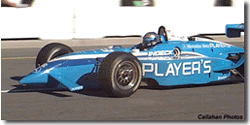The Callahan Report: Tragedy Overshadows Moore's U.S. 500 Victory
26 July 1998
By Terry Callahan
The Auto Channel
BROOKLYN, MI: Three spectators were killed during the running of the U.S. 500 CART FedEx Championship race at Michigan Speedway Sunday. The victims were struck by a tire which flew off during a high speed crash on the race track. Six additional spectators were injured.
Track officials stated that all the dead and injured spectators were adults. Officials would not release the names of the victims until family members could be notified.
The chief medical director for the speedway, Dr. Gregory Baumann, said that two of the spectators died instantly. The third spectator failed to respond to resuscitation efforts at the infield medical care center.
The six injured spectators were transported to Foote Hospital in Jackson Michigan. Their injuries ranged from a broken leg to neck and back pain.
Adrian Fernandez, the polesitter for the race, was the driver involved in the one car crash. Fernandez qualified with a speed of more than 229 mph. Race speeds were in the 220 mph range.
The spectator deaths were the first at a major racing event in more than ten years. In 1987, a fan was killed during the running of the Indianapolis 500 when a tire flew into the grandstand.

|
Driver Greg Moore won the U.S. 500. Moore commented, "People came here to watch us race and put on a good show, which we did today. But that tragedy definitely puts a damper on it."
Greg Penske, the president of Penske Motorsports Inc. (track owners), remarked, "The wall is four feet above the track surface and there's 11 feet of fence and cable. So there's 15 feet from the track surface to the top of the fence. One of the victims was in row eight and another was in approximately row 10"
Gene Haskett, the Speedway president said, "To say how high a fence would have to be to keep debris from going over would be impossible because it's impossible to say how high something would bounce or fly over."
The accident occurred in the turn four area of the track. That area of the grandstand was cleared immediately. The medical examiner quickly ordered an investigation.
A new rear wing was implemented for the cars at this track. The new wing is called the Handford Device. The intent of the wing was to increase drag on the straightaways and decrease downforce in the corners. These two factors would result in a decrease in speed.
While the speeds for the U.S. 500 decreased from those posted the past several years, the new wing allowed the cars to race much closer. The wing "punched" a large hole in the air. The drivers were able to "draft" much like stock cars. The Handford Device worked like a vacuum for the drivers following other race cars.
The new wing may have played a factor in the tragedy at Michigan. Fernandez had just been passed by fellow CART driver Paul Tracy before he lost control of his car and hit the wall. Fernandez said, "When Tracy passed me, he pulled in front of me and took my air away. I got up in the gray (the high part of the track). There was nothing I could do."
Another factor in the tragedy was the design of Indy Style cars. They are made to break apart on impact. This design practice allows the cars to absorb the impact during a crash, instead of the drivers.
The U.S. 500 was the most exciting automobile race ever contested. There were 62 lead changes among nine different drivers. Lead changes are only counted at the start-finish line. There were actually many more lead changes than implied by the "official" statistic. Many of the fans at the track never used their seats. Unfortunately, the racing action is not the headline.


